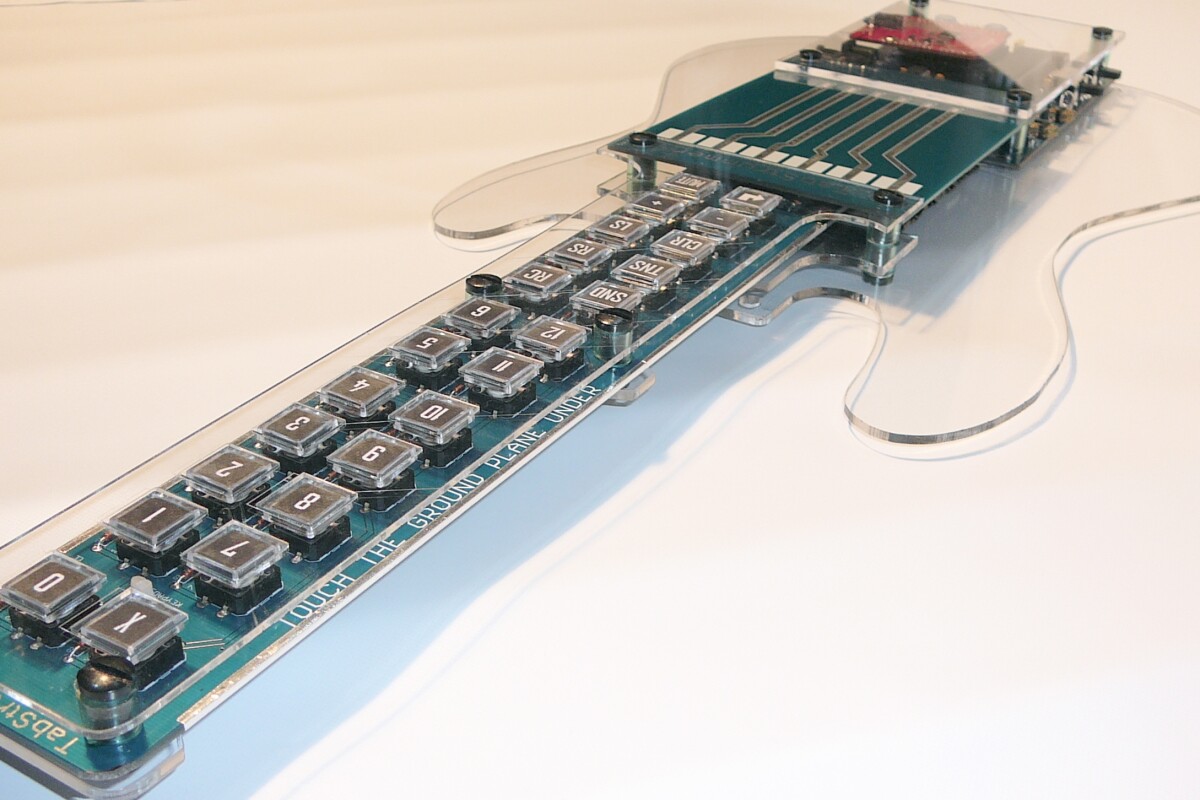
Electronics enthusiast Miroslaw Sowa and programmer Vsevolod Zagainov - both from
Montreal, Canada - are currently busy putting the final touches on a new
button-based, guitar-shaped sound machine called the Tabstrummer. In
the same way that tablature notation has allowed players like me (who
are unable to read score) to learn new songs, this new MIDI instrument
allows folks who'd like to play a guitar, but for whatever reason can't,
the opportunity to easily create some chord-strumming music. The
instrument allows chord shapes to be assigned to clicky buttons on the
short neck, which can then be recalled and played as a song by
simultaneously strumming or picking the virtual strings.

Described
by its creator as a karaoke for your fingers, the Tabstrummer features
an Atmel microcontroller at its heart, touch-sensitive
printed-circuit-board (PCB) trace strings positioned in the familiar
position on the transparent 3mm-thick acrylic guitar body (which are
wide enough apart to enable individual picking as well as full
strumming), and a neck hosting 24 clicky buttons. A dozen of these
buttons can be programmed with a chord shape and stored in the onboard
memory, which retains entries even after the instrument is powered off.
The instrument also features MIDI out and audio out ports.
To
enter a chord shape for later recall, a user presses the RC button on
the neck to activate the Record Chord edit mode. The user is then
prompted to press one of 14 sound-generating buttons - 12 numbered
buttons representing fret positions on a guitar neck, the X button for a
muted string or the O for open string - for each of the six strings. A
user could, for example, mute the bottom E string, then press button
number 2 for the A string, then 2 again for the D string, followed by 1
for the G string, then 0 or mute for the remaining two strings.
When
all of the string values have been chosen, a green LED flashes to
signal that the chord needs to be stored in a memory location for later
recall.
After
12 chord patterns have been stored, a user can then choose to record a
song using the RS button. Up to 300 songs can be stored in the
instrument's onboard memory, and can be subsequently retrieved using the
LS button. The SND button offers eight different guitar-like sounds,
and the TNS button allows the player to raise or lower recorded song
settings by a semi-tone - then the new transposition can be saved to
another memory location.
As
with guitar tab (where a player needs to follow finger/fret positions
marked on a diagrammatic representation of a guitar's six strings in
order to play), the timing, rhythm and some knowledge of how a chosen
song actually sounds will need to come from the user.
The
designers are hoping to release the unit as a build-your-own kit
containing the printed circuit board with surface-mounted components
already soldered in place, and the acrylic body and housing - or as a
fully-assembled model - in Q2 2012. Sowa told us that the Tabstrummer
will likely cost in the region of US$100 to $200.
As
you can see (and hear) from the following demonstration video, the
clicking sound of the buttons may prove to be rather annoying. Perhaps,
if I may be so bold as to suggest, later versions might replace the
clicky buttons with something more like those on the Kitara's
fingerboard.

Comments
Post a Comment